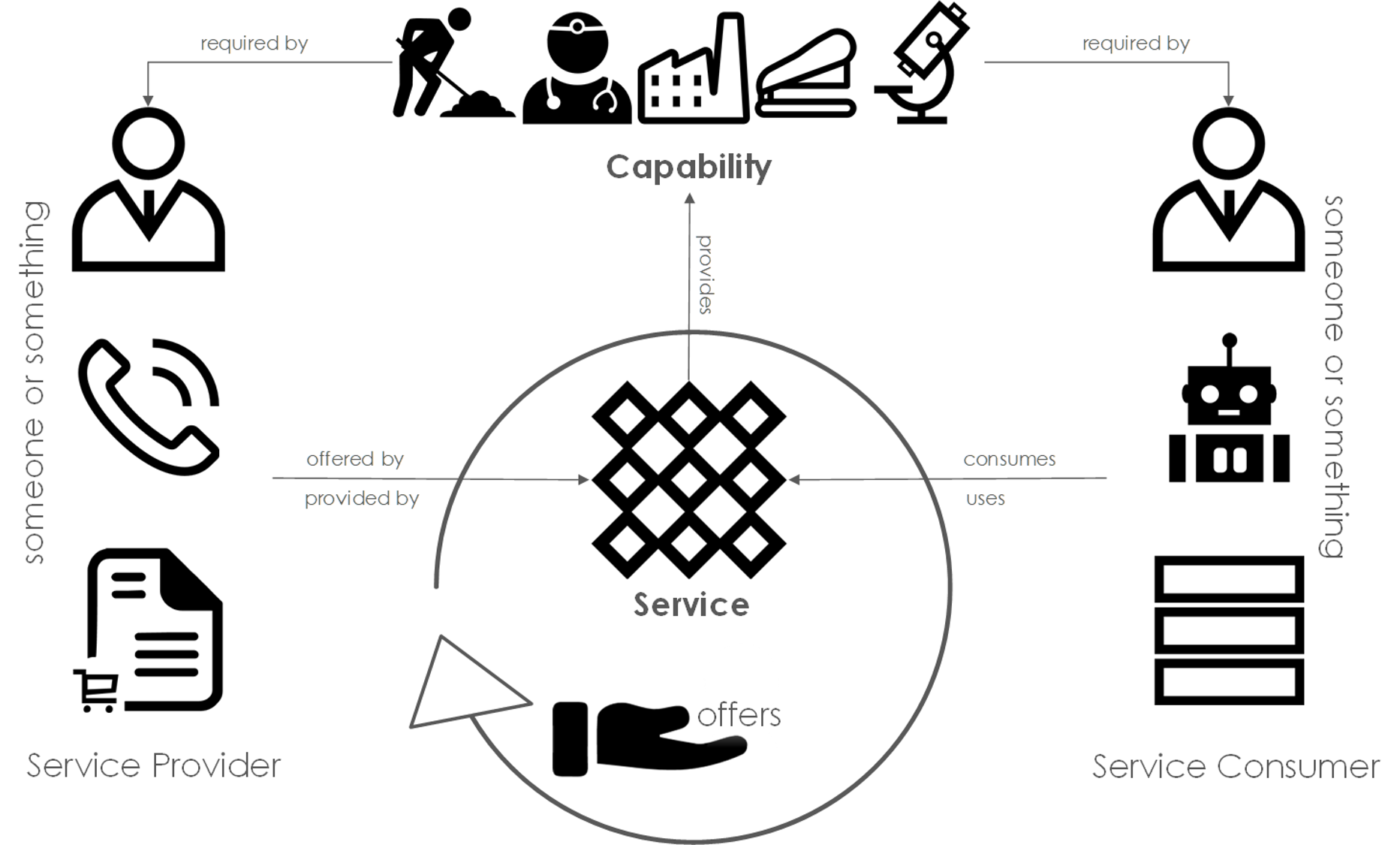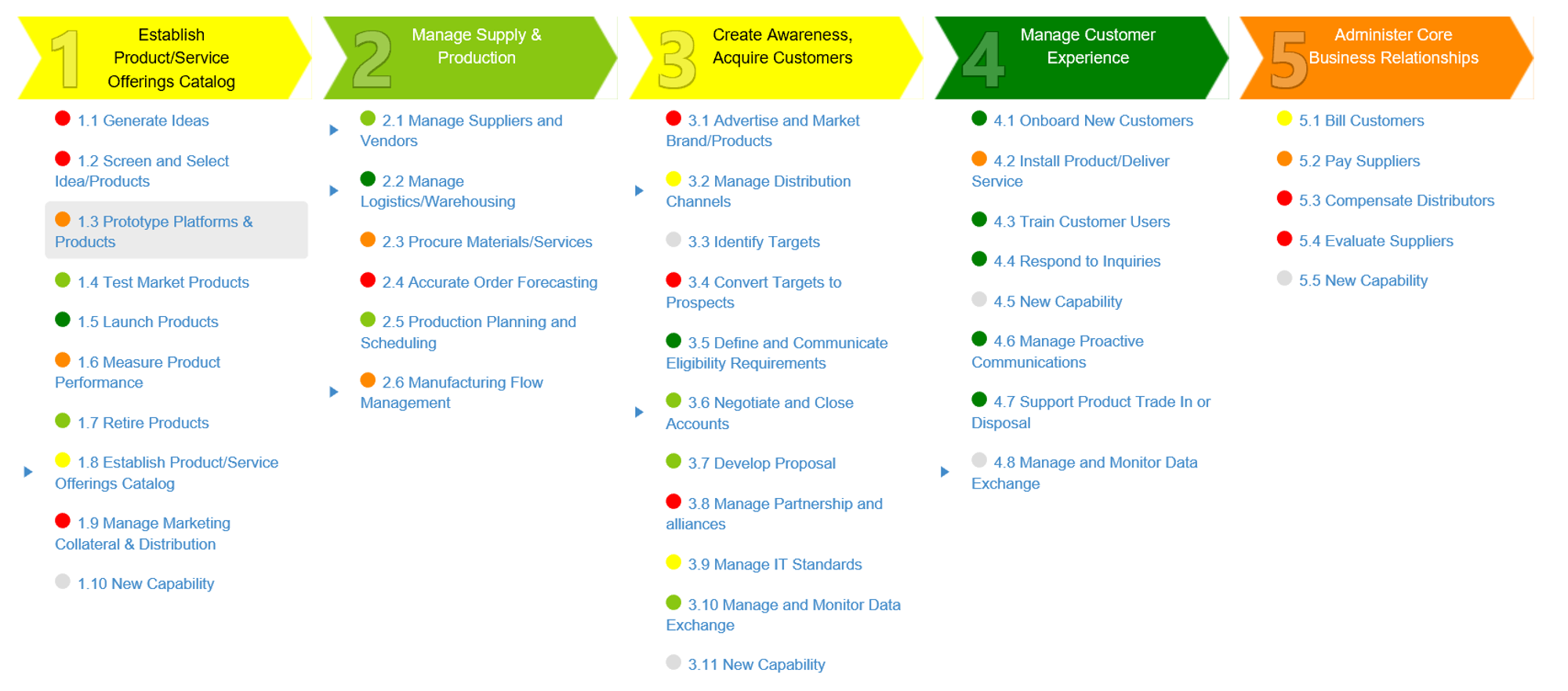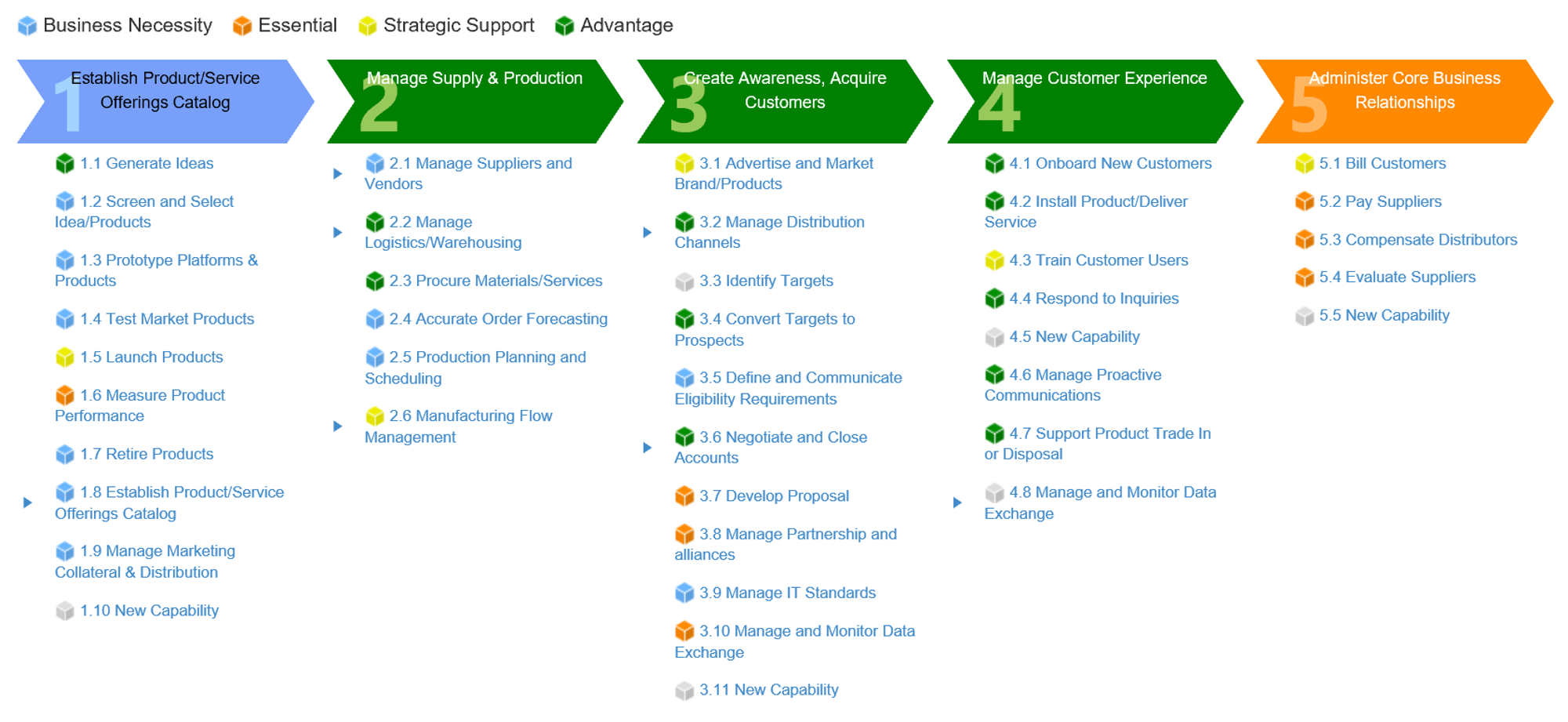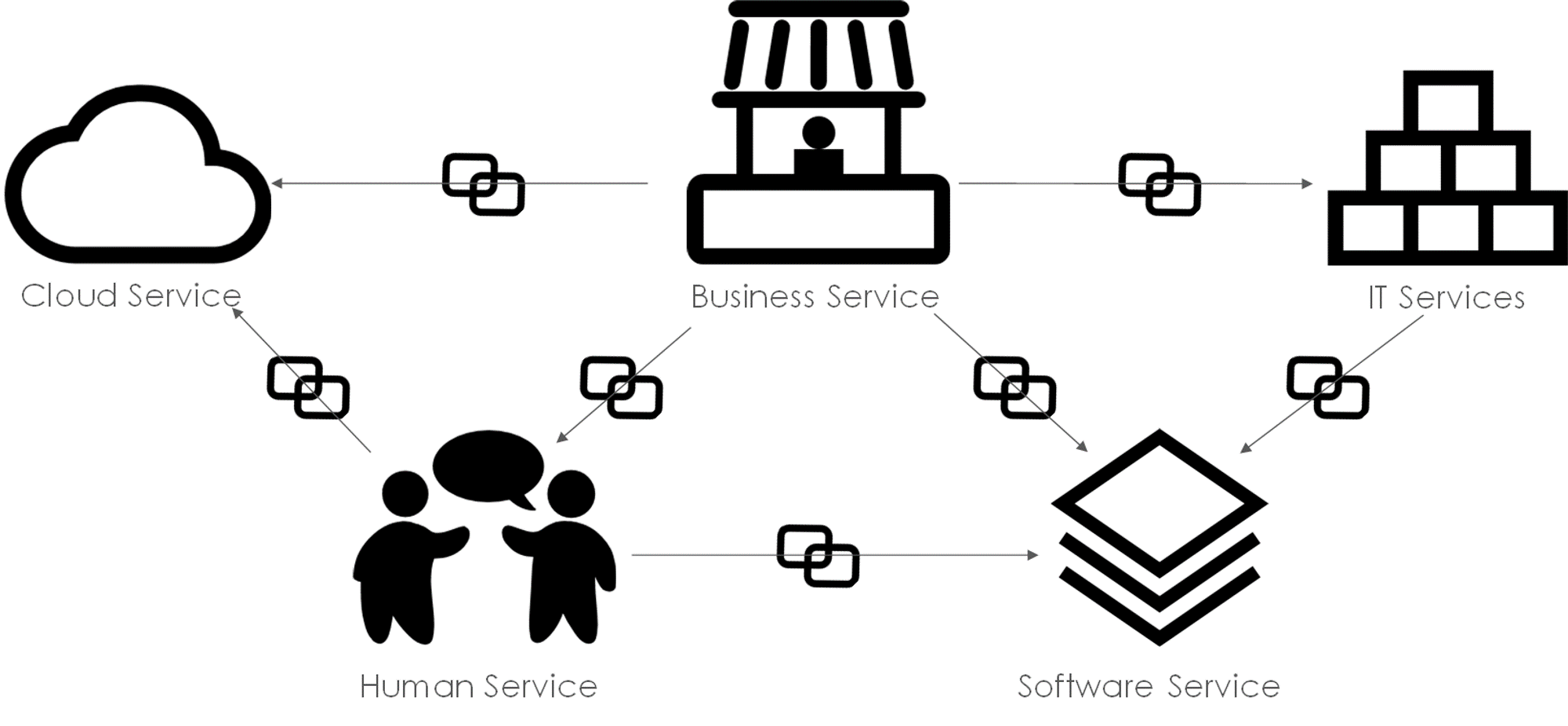Definition
Value Streams represent how and organisation configures it’s business capabilities to deliver value to an internal or external stakeholder typically a customer. The value streams explains how the core value proposition or elements of that value proposition are enabled by the organisations business capabilities. Within more complex Value Chains or within Ecosystems this will include Business Capabilities performed by partners or other Ecosystem participants.
Value streams respond to events or signals that trigger or indicate that a stakeholder wants, needs or desires the outcome ‘the value’ from that value stream. Value Streams include the signal/event, stakeholders (value recipients), stakeholders (enabling participants), value proposition elements
Disambiguation: Lean Value Stream mapping – Lean Value Stream Maps also describe the flow of value resulting from the execution of a set of steps to deliver value to the customer. Value Stream Maps describe the flow of both materials, information and activities within an organisation. Value Stream Maps are ‘how’ focused, they describe the detail of flows with an objective of identifying and eliminating waste. Value Streams as defined here are ‘what’ focused (business capabilities are ‘what and organisation does. The objective is to understand value flow and value configuration. Both techniques are valuable however the level of detail and is different value stream mapping is typically implementation level detail – who, with what. Value streams are design and analytical tools at a less granular level of detail.
Why it matters?
Whether you are trying to bring a new product or service to market, merge or acquire, change your sourcing, transform digitally, enter new markets or optimise operations you will need to understand how value flows to customers and other stakeholders through your organisations capabilities. Value Streams are a method for value configuration in your organisation and allow architects to understand how value flows can be optimised. The challenges that can be revealed and solved using this technique include indiscrimination of customer segments (i.e. standardising where specialisation was more appropriate), understanding dependencies of and linkages between capabilities, understanding impact of regulatory or legislative changes, identifying structural waste and inefficiencies, internationalisation or customisation of products/services, creating new value streams using existing capabilities and last but not least Service Orientation and the designing loosely coupled systems.
Details
Value Streams a or Capability Value Streams represent a viewpoint that capture value flow through capabilities. This method depends on the concept of business capabilities and the discipline of capability mapping [explained BUSINESS CAPABILITIES]. The practices emerged as a result of the inadequacies of other methods namely organisation charts, process flow diagrams and technical blueprints as ways of explaining what an organisation does and how if delivers value. Value Streams are an extension of business capability models and allow an architect to map the flow of value through and organisation and understand what services are involved in the delivery of that value.
Capabilities, Services & Value Streams
Capabilities are linked to each other by services, services in this context are used in a general sense and should not be assumed to be ‘web services’ or ‘micro-services’. The connection between Business Capabilities is via Services and each pair form a consumer/provider pair. From a stakeholder perspective the capabilities are only experienced via the services that expose them, they act as a semi-porous skin on the organisation. From outside and organisation capabilities are only apparent through the services that realise them, their internal working are unclear and may be inferred but not obvious e.g. Uber provides a car-ordering service and a trip-payment service. These provide tangible evidence that Uber must have some sort of car logistics capability, and payments capabilities but its precise inner workings are not visible.

Figure 1: Business Services
Events, Demand Signals & Value Streams
Value Streams are triggered by specific events resulting from external stakeholder actions e.g. placing an order for a domino’s pizza. Events can result from specific commands from stakeholders e.g. Command: Place Order/Event: Order Received , time-based e.g. fixed: end of month or relative: 5 days since event occurred. Demand Signals are the signals passed along the Value Stream between services you can think of them as messages exchanged between cooperating services that enable value to flow.
Proven Practices
Key Deliverables
There are many ways of capturing and the output from a Capability Value Stream, however there is no one standard approach or definition of output. The key to this as with other techniques is to ensure that the deliverable addresses the concerns of the stakeholders. Formal modelling and analysis are useful and create tangible outputs however, the techniques do not depend on any language or toolset
Finding Value Streams
Step 1 in any Value Stream activity is finding the value streams. A number of starting points exist depending on the context.
Customer Starting Points
- Option 1: Products/Service – The easiest starting point is with Products/Services as the tangible manifestation of value as understood by a customer
- Option 2: Business Model – start with the companies business model and explore the value proposition
- Option 3: Ancillary Business Services – Pre/Post activities- returns, faults, complaints, billing, information
Other Stakeholder Starting Points
- Option 4: Financial – find and follow the money
- Option 5: Operational – find and follow the activity
- Option 6: Governance – find and follow the outcomes (rules, policies, principles)
Capability Value Stream Mapping
Goal: Understand the value flow
Purpose: Exploration
Capability Value Stream Mapping is a technique that involves exploring and understanding the capabilities required to deliver on an organisations value proposition to a stakeholder. A generic model looks something like Figure 2: Generic Capability Value stream.
 Figure 2: Archimate 3 – Generic Capability Value Stream – Descriptive
Figure 2: Archimate 3 – Generic Capability Value Stream – Descriptive
The Value Stream describes the value flow, the connections between capabilities indicate boundaries. Concepts such as Bounded Contexts from Domain Driven Design provide a useful way of organising elements of the map. Each exchange between capabilities can be subsequently modelled as a Service Interaction between a consumer & a provider. This approach lends itself to the identification and development of Service Models supporting collaboration across Capabilities.
Scenarios for Use
- Scenario 1: Organisation has an existing Business Capability Model covering the domain
- Scenario 2: Organisation has no business capability model and no familiarity with business capability thinking
Steps
Step 1: Value Stream Storming
- Capture the capabilities (Scenario 1: Use the existing Capability Model/Scenario 2:
- Capture the events
- Capture the services
Step 2: Describe the Service(s) – service consumer/service provider viewpoints
Step 3: Find the Value Flows – how does value flow
Capability Value Streams & Understanding Systems
Systems have a set of characteristics
- Boundaries: boundaries help us understand what’s in and what’s outside of the system, in the context of a value stream we are looking to find where the boundaries lie.
- Hierarchy: systems are often composed of smaller systems which in turn encompass even smaller systems, hierarchies typically come with systems of control which influence behaviours within, in the context value streams we need to understand the impact of hierarchy on value flow.
- Interdependence: The elements within a system need to collaborate to achieve the objectives of the whole system. Often, systems must also collaborate with other systems in the wider environment. Interdependence and collaboration requires the flow of energy, material and information. In the context of value streams we need to understand inter/intra system dependencies and flows.
- Differentiation: Units within a system can be specialised to perform specific functions, such as a Human Resources Department, an Information Technology Department, a Marketing Department, a Production Department and an Executive Board. In the context
- Goals: Systems have a purpose, which they attempt to fulfil. Subordinate elements within an organisation have their own objectives, which may sometimes be counter-productive. This was recently demonstrated by bankers working towards bonuses in a way that threatened the banks they worked for with collapse.
- Regulation: Systems respond to feedback to adjust their behaviour. The banking industry failed to identify, measure and respond to increasing levels of risk, and therefore did not adjust its behaviour to reduce endemic risk levels before the banking crisis took hold
Capability Value Stream Performance Analysis
Inputs: Capability Value Stream Map, Business Capability Model
Goal: Understand impact of capability performance on value flow
Purpose: Find the pain
Each Capability exhibits a level of Performance based on the efficiency and effectiveness of that capability. There are a number of approaches to establishing the performance both absolute numbers, performance indicators, expert judgement. The goal is to quickly establish a map of performance as it relates to value streams.

TODO: Figure 4: Capability Value Stream
Scenarios for Use
- Scenario 1: Organisation has an existing Business Capability Model covering the domain with performance pre-measured (see Figure 3)
- Scenario 2: Organisation has no business capability model, capabilities must be captured and performance measured
Steps
Step 1: Map Capability Performance to the Capability Value Stream
Step 2: Identify Key Pain Points (Performance Impacts)
Step 3: Identify Structural or Flow Pain Points i.e. the configuration of capabilities in the flow
Step 4: Identify Information Gaps/Assumptions/Inconsistencies
Step 5: Identify Pain Relief/Value Maximising Options
Step 6: Describe/Set future state performance characteristics
Capability Value Stream Contribution Analysis
Inputs: Capability Value Stream Map, Business Capability Model, Capability Performance Map
Goal: Understand capability contribution on value flow
Purpose: Find what’s important
Capabilities come in all shapes and sizes. Capability Contribution captures the impact of the capability along 2 dimensions – Strategic/Value Proposition and Financial (Cost/Revenue). Capabilities classified as
- Advantage: Capabilities with high value proposition impact AND drive financial results
- Strategic Support: Capabilities with high value proposition impact AND little financial impact
- Essential: Capabilities that drive financial performance but not little value proposition impact
- Business Necessity: Capabilities that are necessary but not seen as creating value or driving financial performance

Figure 5: Capability Contribution
Scenarios for Use
- Scenario 1: Organisation has an existing Business Capability Model covering the domain with contribution pre-measured (see Figure 3)
- Scenario 2: Organisation has no business capability model, capability contribution is no
Steps
Step 1: Map Capability Contribution to the Capability Value Stream
Step 2: Identify High Impact Capabilities
Step 3: Identify Business Necessity/Essential capabilities participation in the Value Stream
Step 4: Identify Information Gaps/Assumptions/Inconsistencies
Step 5: Identify Value Maximising Options
Capability Value Stream Service Orientation Analysis
Inputs: Capability Value Stream Map, Business Capability Model
Goal: Understand Service Boundaries, Service Interactions and Value Flow
Purpose: Find Services, Service Boundaries

Figure 6: Services are Connected
Capability Value Stream Financial Analysis
Inputs: Capability Value Stream Map, Business Capability Model, Business Capability Contribution Maps
Goal: Understand Service Boundaries, Service Interactions and Value Flow
Purpose: Find Financial Impacts Cost/Revenue
Capability Value Stream Regulatory Impact
Inputs: Capability Value Stream Map, Business Capability Model, Business Capability Contribution Maps, Regulatory Frameworks
Goal: Understand Impact of New/Updated Regulation
Purpose: Find Regulatory Impact
- Scenario: Example – GDPR implications for a value
Related Concepts
- Customer Journey Mapping
- Service Blueprinting
- Business Capability Modelling
- Event-storming
References
Value Streams Wikipedia https://en.m.wikipedia.org/wiki/Value_stream
SAFE 2.0 http://www.scaledagileframework.com/value-streams/
Entabula – Sehmi, Lloyd, Deacon, Mac Críosta BIZBOK http://www.businessarchitectureguild.org/page/About
SOA Patterns – Thomas Erl http://www.soapatterns.org/
Service Choreography https://en.wikipedia.org/wiki/Service_choreography
Identifying Value Streams http://www.scaledagileframework.com/identify-value-streams-and-arts/

BTABoK 3.0 by IASA is licensed under a Creative Commons Attribution-NonCommercial–NonCommercial 4.0 International License. Based on a work at https://btabok.iasaglobal.org/